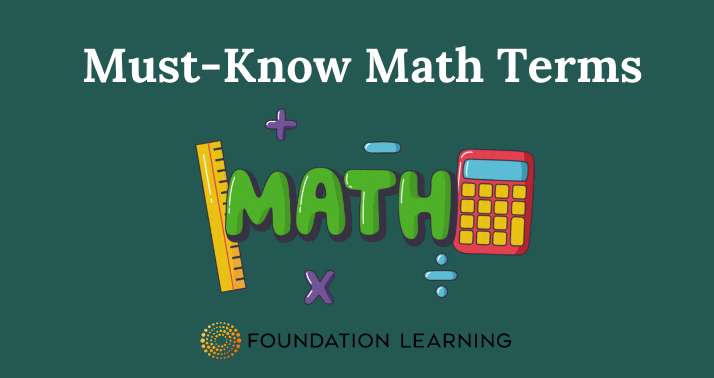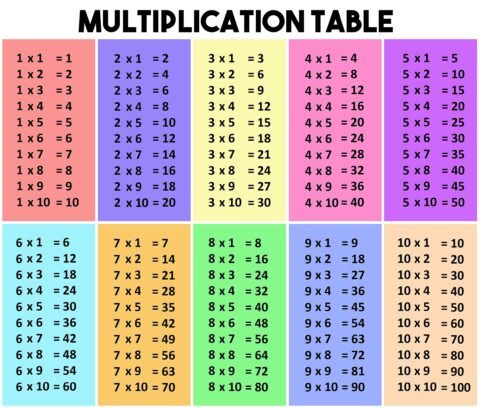Math can often feel like a different language, filled with specific terminology that can be confusing if you are not familiar with the terms. Whether you are just beginning to explore mathematical concepts or need a refresher, this guide will help you understand some of the most common math terms and their meanings. We’ll cover a wide range of topics, such as what mean means in math, what a function is, how to find the range, and much more.
What Does “Mean” Mean in Math?
In math, the mean refers to the average of a set of numbers. To calculate the mean, you add up all the numbers in a data set and then divide the sum by the number of items in that set. For example, if you have the numbers 5, 10, and 15, their mean is calculated as follows:
Add the numbers: 5 + 10 + 15 = 30
Divide by the number of items: 30 ÷ 3 = 10
So, the mean is 10. The mean provides a measure of central tendency, showing you what a typical value from the data set might look like.
What Does “Product” Mean in Math?
The product in math refers to the result of multiplying two or more numbers together. For example, the product of 4 and 5 is 20 because 4 × 5 = 20. The concept of a product is fundamental to understanding multiplication, which is one of the four basic operations in arithmetic.
Who Invented Math?
The origins of math are difficult to trace, as it developed over thousands of years in various civilizations. Early evidence of mathematical activity can be traced back to the ancient Egyptians and Mesopotamians around 3000 BC. Greek mathematicians like Euclid and Pythagoras played significant roles in shaping the field of mathematics as we know it today. Archimedes is often considered one of the greatest mathematicians of ancient times.
How to Find the Range in Math
In mathematics, the range is the difference between the highest and lowest values in a data set. To find the range, simply subtract the smallest number from the largest number. For instance, if your data set includes the numbers 3, 7, 10, and 15, the range is calculated as follows:
Largest number: 15
Smallest number: 3
Range: 15 – 3 = 12
The range provides insight into the spread of values in a data set.
What Color Is Math?
While math doesn’t inherently have a color, students often assign colors to subjects to help with organization. In this informal context, many people consider math to be associated with the color red or blue.
What Does “And” Mean in Math?
In mathematical logic, “and” is used to indicate that two conditions must be true simultaneously. It is commonly used in set theory and logical statements. For example, in the context of inequalities, “x > 3 and x < 10” means that x must be greater than 3 and less than 10.
What Is a Function in Math?
A function in mathematics is a relation between a set of inputs and a set of possible outputs, where each input is related to exactly one output. Functions are often written in the form f(x), where x is the input and f(x) represents the output. For instance, in the function f(x) = 2x + 3, if you plug in x = 2, the output will be f(2) = 2(2) + 3 = 7.
What Is the Median in Math?
The median is the middle value of a data set when the numbers are arranged in ascending or descending order. If the data set has an odd number of values, the median is the middle value. If it has an even number of values, the median is the average of the two middle values. For example, in the data set 3, 5, 8, the median is 5. In the data set 1, 3, 7, 9, the median is (3 + 7) ÷ 2 = 5.
What Is Mode in Math?
The mode is the number that appears most frequently in a data set. For instance, in the set 2, 4, 4, 5, 7, the mode is 4 because it appears more times than any other value.
What Is a Constant in Math?
A constant in math is a value that does not change. It is a fixed number. For example, in the equation y = 3x + 5, the number 5 is a constant because its value remains the same no matter what value x takes.
What Is a Term in Math?
A term in math refers to a single number or variable, or the product of numbers and variables. In the expression 5x + 3y – 7, the terms are 5x, 3y, and -7.
What Does “e” Mean in Math?
In mathematics, “e” is an important constant approximately equal to 2.71828. It is the base of the natural logarithm and is used extensively in calculus, particularly in problems involving growth and decay.
What Is a Domain in Math?
The domain of a function is the set of all possible input values (usually represented by x) for which the function is defined. For example, if you have the function f(x) = 1/x, the domain excludes x = 0 because division by zero is undefined.
What Is a Factor in Math?
A factor is a number that divides another number without leaving a remainder. For example, the factors of 12 are 1, 2, 3, 4, 6, and 12.
What Is Volume in Math?
Volume is the measure of the amount of space that a three-dimensional object occupies. It is expressed in cubic units. For example, the volume of a cube with side length 3 is 3 × 3 × 3 = 27 cubic units.
How to Find the Mean, Median, and Mode in Math
Mean: Add all the numbers and divide by the count of numbers.
Median: Arrange the numbers in order and find the middle value.
Mode: Identify the number that appears most frequently.
These three measures are commonly used in statistics to describe the central tendency of a data set.
What Is an Outlier in Math?
An outlier is a value in a data set that is significantly higher or lower than the other values. For example, in the data set 3, 4, 5, 100, the number 100 is an outlier because it is much larger than the other values.
What Is Standard Form in Math?
Standard form can refer to different things in math, depending on the context. In algebra, standard form often means writing a polynomial in descending order of power, such as ax^2 + bx + c. In arithmetic, standard form can also refer to scientific notation, like 3.5 × 10^4.
What Is a Coefficient in Math?
A coefficient is a number that multiplies a variable. For example, in the term 7x, 7 is the coefficient.
What Is a Ray in Math?
A ray is a part of a line that starts at a specific point (called the endpoint) and extends infinitely in one direction. It is often represented with an arrow.
What Is an Array in Math?
An array in math is a visual representation of objects or numbers arranged in rows and columns. Arrays are commonly used to illustrate multiplication and division concepts.
What Is a Variable in Math?
A variable is a symbol, usually a letter, that represents an unknown value. For example, in the equation x + 5 = 10, x is the variable.
What Is a Vertex in Math?
A vertex is a point where two or more lines or edges meet. In geometry, a triangle has three vertices, while a cube has eight.
What Is a Unit Rate in Math?
A unit rate is a comparison of two different quantities where one of the quantities is 1. For example, if you drive 60 miles in 2 hours, the unit rate is 30 miles per hour.
What Is an Integer in Math?
An integer is a whole number that can be positive, negative, or zero. Examples include -3, 0, 7.
What Is Discrete Math?
Discrete math is the study of mathematical structures that are countable or distinct. It includes topics such as graph theory, logic, and combinatorics, and is widely used in computer science.
What Is a Prime Number in Math?
A prime number is a natural number greater than 1 that has no positive divisors other than 1 and itself. Examples include 2, 3, 5, 7, 11, etc.
Conclusion
Math is a vast field with many different concepts, each serving a unique purpose. Understanding the terminology is the first step to mastering the subject. Whether you want to know how to find the mean, what a function is, or who invented math, knowing these terms will help you navigate the world of mathematics with greater ease. Keep practicing, and you’ll see how these concepts come together to form a comprehensive understanding of math.



